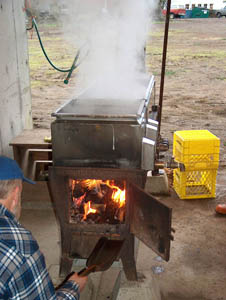The Vancouver Island Maple Project has just wrapped up its first major production season. The purpose of the Project is to explore, promote and develop a cottage industry on the Island producing various products derived from the sap collected from the native west coast Bigleaf Maple (Acer macrophyllum). This may include traditional items such as syrup and new innovations like maple sap wine, sap beverages (maple "pop") and wholly or partly concentrated culinary sap products. Not many of us have tasted maple mint tea, maple flavoured rice, or maple based soups.
The Project hosted four extension workshops over the winter in Ladysmith, Port Alberni and Oyster River to demonstrate techniques and equipment. More than eighty-five private landowners, forest managers, and provincial representatives attended. Taps, tubing and other material was purchased in bulk from eastern suppliers and sold to the landowners with a small profit collected for future purchases.
 |
This wood-fired evaporator helped members of the Vancouver Island Maple Project process over 2,500 litres of sap in 2003. (Photo courtesy Harold Macy) |
Sap Production
The season starts early on Vancouver Island, with the first taps going in around November 7 with great flows and good sugar content. Multiple coppice stems produced better from November 26 to Christmas than they did in January. In December our single stems did poorly compared to January. In our area, you might miss half the potential volume if you wait until after Christmas to tap. Sugar content averaged 2 - 3% brix, and average flow was two litres per taphole/day. The best producing trees, in terms of sugar and volume, were twenty-year-old coppices arising from a stump. Good southern exposure was also noted as being conducive to production.
Conventional literature on the subject emphasizes weather as being a primary consideration for sap flow. Diurnal temperature fluctuations are often noted as the primary influence. Due to the Island's maritime climate, we found that while the daily warm and cold cycles are no doubt influential, changes of barometric pressure were also observed as having a noticeable effect.
Some of the producers used traditional spiles and buckets, however the major collectors relied on plastic taps and tubing, gathering several stems into a single collecting tank. This closed system reduced contamination and dilution by rain or snow.
Sap flows per stem can be quite significant. one tree with a single spile tapping, yielded close to 200 litres of sap during the season, enough to make about five litres of Vancouver Island maple syrup. Unfortunately some trees are not nearly as productive. More research is planned to see if there is a way of identifying ideal tapping trees. Although general guidelines exist, finding the best trees currently is a trial and error approach. Some very unlikely trees give good results, while other ideal candidates are non-performers.
Syrup and Wine
Tins of Vancouver Island maple syrup samples were provided by Gary Backlund to selected restaurants and natural food stores during the season for promotion and test marketing. From initial feedback, there appears to be a strong demand for the product, not only as pancake syrup, but also as a specialty item for gourmet cooking. Due to the syrup's strong and excellent flavour, it is ideal for this application.
The parallel development of maple sap wine continues to receive enthusiastic support. one advantage of this product is that one litre of sap makes one litre of wine, in contrast to the approximately forty to one reduction ratio for syrup. Due to the availability of West Coast Maple Syrup, it has become possible for the vintner, Bram Lucieer, to conduct research involving sap and syrup combinations.
New Equipment
This year, the early warm Spring dictated the cessation of collecting sap by the first of March. Now the taps are out of the trees and the equipment has been cleaned and put away for another year. "We processed over 2,500 litres of sap collected by the participating farmers and rural landowners," says Harold Macy, Agroforestry Manager at UBC Oyster River Research Farm.
"We received a big boost this winter by obtaining a wood-fired commercial evaporator which really increased our capacity and product quality," Macy said. "It has a 45cm x 150 cm two-part pan. The flue pan has one partition and 12 cm drop flues for fast boiling, the syrup pan is flat bottomed with one partition. It has a capacity of sixty litres an hour. We used about two cords of firewood for the season."
A propane burner was used for the final finishing of the syrup. Innovations for improving the rate for next year will include a sap pre-heater and fireproof gaskets around the primary evaporator to reduce cold air intake.
Besides increasing the participation of landowners, next year's goals include the identification of suitable maple stands, developing a marketing and publicity strategy, ensuring a safe and standardized product and hosting more training workshops.
For more information contact Harold Macy at This email address is being protected from spambots. You need JavaScript enabled to view it., Gary Backlund at This email address is being protected from spambots. You need JavaScript enabled to view it., or Bram Lucieer at This email address is being protected from spambots. You need JavaScript enabled to view it..
By Harold Macy
University of British Columbia, Oyster River Research Farm



